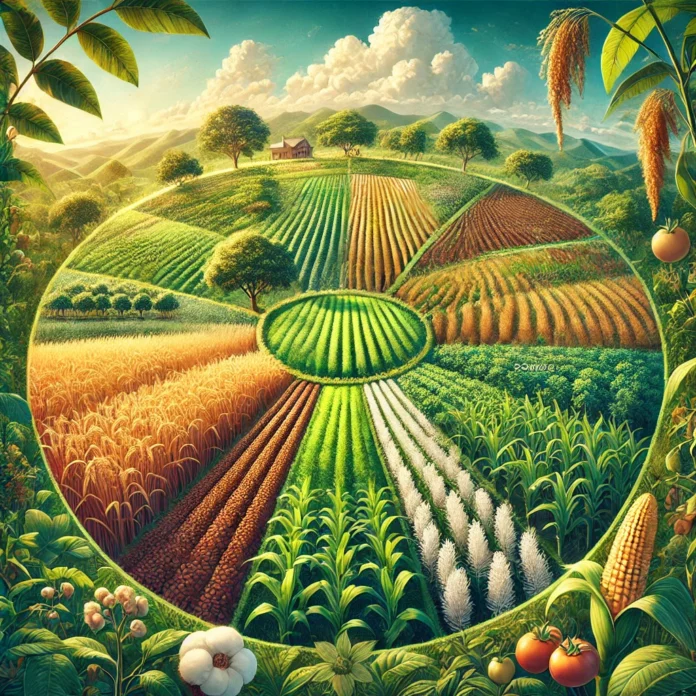Introduction
Crops form the backbone of global food security, sustaining billions of lives and driving economies worldwide. From staples like rice and wheat to cash crops like coffee and cotton, agriculture plays a pivotal role in international trade and development. This article explores the top 10 crops grown globally, their economic significance, and the countries that dominate their production.
The Top 10 Crops and Their Impact
- Wheat
- Economic Impact: Wheat is a staple food for over 35% of the global population and contributes significantly to global trade, especially in regions like Europe, North America, and Asia. It generates billions annually and supports major economies like the U.S., China, and Russia.
- Top Producers: China, India, Russia, and the United States lead in wheat production.
- Rice
- Economic Impact: Rice feeds more than half of the world’s population. It’s a key agricultural product in Asia, fostering rural employment and food security.
- Top Producers: China, India, Indonesia, and Vietnam dominate global rice production.
- Corn (Maize)
- Economic Impact: Beyond being a food staple, corn is crucial for livestock feed and biofuel production. The crop significantly boosts agricultural GDP in countries like the U.S. and Brazil.
- Top Producers: United States, China, Brazil, and Argentina.
- Soybeans
- Economic Impact: As a critical source of protein and oil, soybeans fuel the livestock and food industries. Its rising demand drives global exports.
- Top Producers: United States, Brazil, and Argentina.
- Cotton
- Economic Impact: Cotton’s contribution to the textile industry makes it an economic powerhouse, providing livelihoods to millions of farmers globally.
- Top Producers: India, China, United States, and Brazil.
- Coffee
- Economic Impact: Coffee is among the most traded commodities, supporting economies across Central and South America, Africa, and Asia.
- Top Producers: Brazil, Vietnam, Colombia, and Ethiopia.
- Sugarcane
- Economic Impact: Sugarcane drives the global sugar and ethanol industries, significantly impacting economies in tropical regions.
- Top Producers: Brazil, India, China, and Thailand.
- Potatoes
- Economic Impact: Potatoes are a vital crop for food security and economic stability in Europe and Asia.
- Top Producers: China, India, and Russia.
- Bananas
- Economic Impact: Bananas are a critical cash crop for tropical countries, supporting smallholder farmers and export revenues.
- Top Producers: India, China, Philippines, and Ecuador.
- Tomatoes
- Economic Impact: Beyond their dietary importance, tomatoes are essential for processed foods, driving agricultural exports.
- Top Producers: China, India, and the United States.
Global Trends in Crop Production
1. Rising Demand for Sustainable Practices As consumers prioritize sustainability, there is an increasing push for eco-friendly agricultural practices, such as organic farming and reduced water use.
2. Technology and Innovation Advancements in precision agriculture, genetic engineering, and smart irrigation systems are boosting yields and efficiency.
3. Impact of Climate Change Shifting weather patterns and extreme events challenge crop production, necessitating adaptive strategies to ensure food security.
4. Global Trade Dynamics Trade policies, tariffs, and geopolitical events significantly impact the global flow of crops, influencing prices and market access.
Economic Significance of Top Producers
1. United States The U.S. leads in corn and soybean production, with agriculture contributing substantially to its GDP.
2. China China’s dominance in rice, wheat, and potatoes underpins its agricultural strength, sustaining its massive population and supporting global exports.
3. India India’s vast production of rice, wheat, and cotton fuels its domestic economy and supports significant exports to neighboring countries.
4. Brazil As a top producer of soybeans, coffee, and sugarcane, Brazil’s agricultural exports play a crucial role in global trade.
Conclusion
The economic impact of crops cannot be overstated. From feeding populations to driving industries, the top 10 crops play an essential role in global economies. Understanding the trends, challenges, and opportunities in agriculture is crucial for policymakers, businesses, and consumers to ensure sustainable growth.

